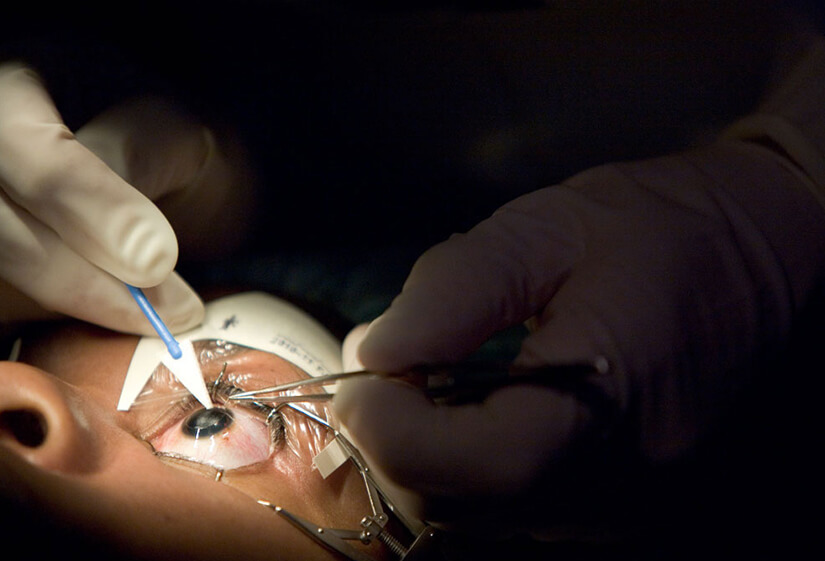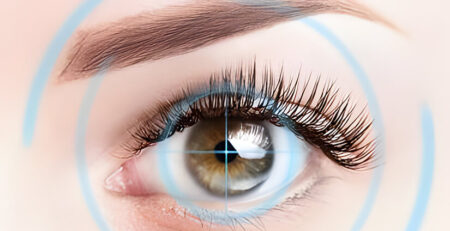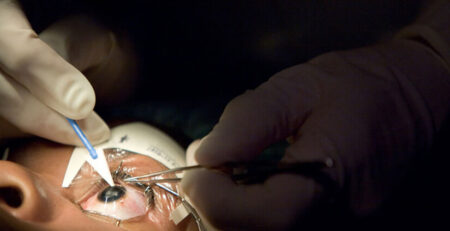What is Refractive Surgery?
Refractive surgery is a surgical procedure that corrects refractive errors of the eye, such as nearsightedness, farsightedness, and astigmatism. Refractive surgery is the most effective option for those tired of wearing glasses or contact lenses.
But how does refractive surgery work, and what are the different types of refractive surgeries? Let’s explore.
Refractive errors occur when the light entering the eye is not properly focused on the retina, the light-sensitive tissue at the back of the eye. This can cause blurry vision due to nearsightedness (myopia), farsightedness (hyperopia), or astigmatism.
Refractive surgery corrects these refractive errors by shifting the focus at the retina. This is achieved by either reshaping the cornea, the clear front part of the eye or adding/changing the power of the focussing lens inside the eye.
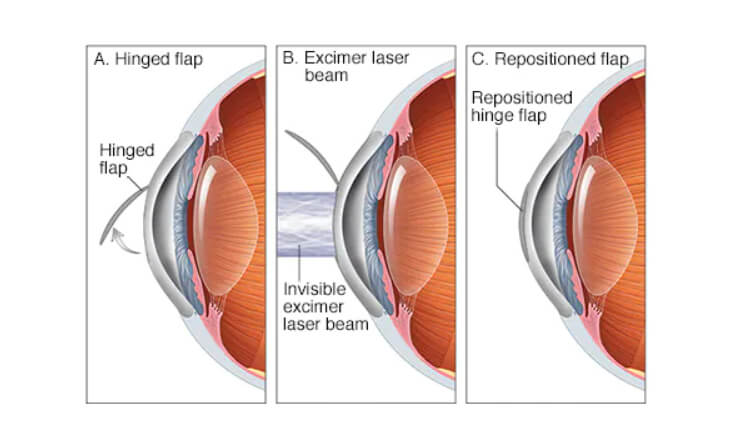
What are the Types of Refractive Surgeries?
While LASIK is the most popular refractive surgery, many other techniques are used to treat refractive errors. These techniques include:
LASIK (Laser in Situ Keratomileusis): LASIK is a widely performed refractive surgery that uses a focused laser beam to reshape the cornea and improve vision. This procedure helps to treat refractive vision issues like nearsightedness, farsightedness, or astigmatism. This modern technique improves vision by creating a thin corneal flap, then using an excimer laser for precise reshaping of the cornea by the surgeon. Before undergoing LASIK, your vision must reach a stable state, meaning your eyeglass or contact lens prescription has remained consistent.
There are different types of LASIK:
- Blade LASIK or Traditional LASIK: This involves a microkeratome (a type of blade) to create a thin flap. The Flap is then lifted to expose the underlying tissue. Then, an excimer laser reshapes the cornea, and the flap is repositioned.
- SBK LASIK: SBK (Sub-Bowman’s Keratomileusis) LASIK is used in people with thinner cornea or high power. In this refractive surgery procedure, a special blade is used to create a flap thinner than the conventional lasik, and the rest of the procedure is similar to blade LASIK.
- Bladeless LASIK: Bladeless LASIK or femtoLASIK is a modern technique where the flap is created with a laser called Femto Laser. The laser creates the precise flap, then the excimer laser reshapes the cornea, and finally, the flap is repositioned. This procedure does not involve a blade.
- Custom or Wavefront-Guided LASIK: Custom or Wavefront-Guided LASIK is the most advanced laser technology to treat refractive errors by creating a 3D map of the eye. Custom or Wavefront-Guided LASIK refractive surgery offers a highly tailored and individualized vision correction solution that addresses common issues like nearsightedness, farsightedness, and astigmatism and targets additional optical imperfections known as higher-order aberrations. The significance of these higher-order aberrations varies from person to person. Individuals with notable higher-order aberrations may experience issues such as glare, halos, and potential reductions in night vision after Lasik, even if their nearsightedness, farsightedness, and astigmatism have been corrected.
- Topography-guided LASIK: Topography-guided LASIK is an advanced type of bladeless LASIK that uses a detailed cornea map to customize the treatment for each patient. This can help to improve vision and reduce the risk of side effects, such as glare and halos. Contoura vision is a type of topography-guided LASIK refractive surgery.
- Epi-LASIK: Epi-LASIK is a type of laser eye surgery that is used for people with thinner corneas or difficult corneal access. In epi-LASIK, a flap is created in the cornea using an epikeratome tool. The flap only involves the epithelium, which is the outermost layer of the cornea. The rest of the procedure is similar to bladeless LASIK or blade LASIK, which involves lifting the flap, reshaping the cornea, and replacing the flap.
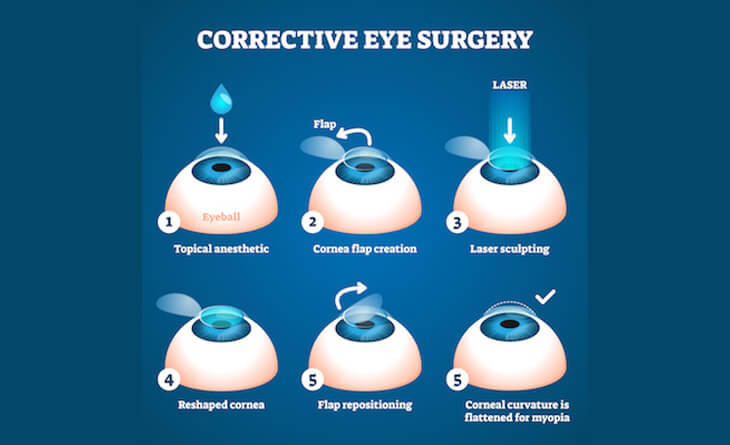
PRK (Photorefractive Keratectomy): PRK is similar to Epi-LASIK but involves removing the cornea surface epithelium rather than creating the flap. PRK refractive surgery is typically used to correct mild to moderate refractive errors. Unlike Lasik, post-op recovery in PRK takes a few weeks. PRK is an excellent alternative option for those who have a thin cornea, chronic dry eyes, or a high-prescription strength that may eliminate LASIK as an option.
SMILE (Small Incision Lenticule Extraction): SMILE is a newer type of refractive surgery that uses a femto laser to create a lenticule, or small piece of tissue, inside the cornea. The lenticule is then removed through a very small incision on the surface, which reshapes the cornea. This technique is used to correct nearsightedness.
ICL (Implantable Collamer Lens): Instead of reshaping the cornea, ICL involves implanting the thin lens inside the eye. These lenses are similar to contact lenses but remain stable within the eye, causing no irritation or need for removal. ICL is often used for individuals with very high levels of myopia or hyperopia, or in eyes unfit for lasik.
Clear Lens Extraction or Refractive Lens Exchange (CLE/RLE): This procedure involves replacing the eye’s natural lens with an IOL (intra-ocular lens) to correct the refractive errors. RLE can be used to correct presbyopia or near vision glasses. It is also a good choice for people with high powers who are unfit for both LASIK and ICL. In this procedure, a small incision is made to remove the natural lens and an IOL is placed through the same incision.
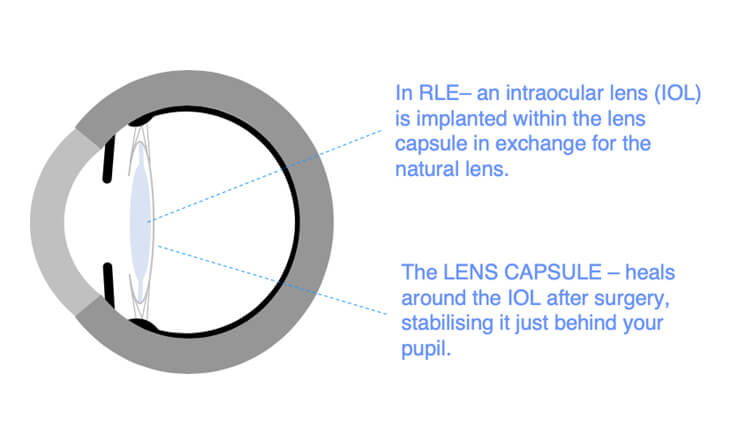
When is the right time to get refractive surgery?
The right age to get refractive surgery depends on several factors, including age, eye health and lifestyle. Usually, the surgeon recommends refractive surgery for patients after 21 years because, at this time, your glass power tends to stabilize.
Your glass power can undergo changes, especially during your teenage years. A prematurely done refractive surgery may still lead to glass power within a few years as the eye is still growing and power is still changing.Therefore, waiting until you are 21 before undergoing LASIK refractive surgery is advisable.
Also, if you are pregnant, breastfeeding or taking steroids, you should postpone considering LASIK eye surgery until your vision has reached a stable state after these conditions or medications have been resolved. Pregnancy, breastfeeding or taking steroids can fluctuate your vision.
Who can get LASIK done?
While LASIK is a safe and effective procedure to remove contact lenses or eyeglasses, it is not suitable for everyone. Here are the eligibility criteria for LASIK:
Stable Prescription: A stable glasses or contact lens prescription is the most important thing to consider while undergoing LASIK. LASIK refractive surgery does not stop increasing the glass power; it will neutralize your glass power. Therefore, you must wait until you are 21 years old so your eyeglass prescription stops changing. If your number is still increasing at age 21, you must wait a little longer to stabilize your power.
Also, if you are pregnant or lactating, you should wait for some time because the glass power changes during this time due to hormonal changes.
Corneal Thickness and shape: You need to have sufficient corneal thickness for LASIK. The procedure involves reshaping the cornea, and having a thick enough cornea is important to avoid complications. Also the corneal shape should be normal and not an indicator of keratoconus or steep cornea. This is checked with a few eye tests like pentacam or topography.
Eye Health: Before considering LASIK, make sure you have no other eye problems like dry eyes, ocular injury, glaucoma, cataract or ocular infection, as these problems can interfere with recovery and result.
Healthy Person: Besides a healthy eye, overall health and immune system function are also considered before undergoing LASIK refractive surgery. If you have any other medical condition, like rheumatoid arthritis, HIV, Systemic Lupus Erythematosus or other auto-immune disorder, you may not be a suitable candidate for LASIK. Also, uncontrolled diabetes may interfere in healing, so the blood sugar levels should be controlled before considering surgery.

How much does LASIK cost?
The LASIK refractive surgery cost depends on various factors, including:
Type of LASIK and the Technology Used: The cost of LASIK depends on the type of LASIK. There are different machines and technologies used for LASIK. The most common type of LASIK is traditional or blade LASIK, which uses a blade to create the flap and then reshape the cornea. The cost of the blade LASIK lies between 30000 and 40000 INR for both eyes. In contrast, the cost of SBK is between 40000 to 45000 INR. It would be costlier if you choose more advanced technology, i.e., bladeless LASIK, which uses a femtosecond laser to create the flap. The cost will lie between 80000 IRN to 1 Lakh.
Location: The location of the clinic or hospital can significantly impact the refractive surgery cost. LASIK is typically costlier in the major cities than in smaller towns or rural areas.
The Surgeon’s Experience and Expertise: The surgeon’s experience and expertise are other important factors that can affect the refractive surgery cost. More experienced surgeons with a track record typically charge more than less experienced surgeons.
What are the Precautions After LASIK Surgery?
LASIK surgery is a safe and popular vision correction procedure that can permanently remove the glasses or contact lenses. However, it is important to follow the precautions after LASIK surgery to prevent complications and ensure a smooth recovery. Here are a few precautions that you need to take care of after LASIK surgery:
Put Eye Drops Regularly: Your eye specialist in Delhi will prescribe eye drops to help keep your eyes moist and help with pain, inflammation, and infection. Use these drops as prescribed, even if your eyes feel fine.
Avoid Putting Water in Your Eyes: You can take a shower below the chin and shampoo your hair, but avoid putting water in your eyes for the first 10-15 days.
Avoid Rubbing Your Eyes: Avoid touching or rubbing your eyes for at least 15 days after LASIK because rubbing can dislodge the corneal flap created during LASIK surgery and lead to complications.
Avoid Facial or Eye Makeup: Women should avoid threading, facial or any other eye makeup for one month as it can irritate the eyes and increase the risk of infection.
Avoid Strenuous Activities: For one month, you should avoid gym and other strenuous activities to encourage smooth recovery.
Avoid Swimming and Water Sports: Avoid swimming pools, hot tubes, lakes and other water sports for 3 months because water contains several bacteria that cause eye injections.
Avoid Screen: LASIK can cause dryness in your eyes. Watching TV, laptop, or mobile can increase the dryness. Therefore, completely avoid computer or mobile screens for the first 3-4 days. After that, if you feel comfortable, you can start working on your computer for a limited time.
Avoid Driving: You may have blurred vision for 1-2 days after LASIK. During this time, there are chances of accidents. Therefore, you should avoid driving for at least one week.
Avoid Outdoor Activities: Avoid outdoor activities for one week. If you need to go outside, wear protective eye glasses to keep your eyes safe from dirt, dust, UV rays and other debris.
Get Plenty of Rest: Your eyes will need time to heal, so it is important to get plenty of rest. Avoid staying up late and napping during the day.
Follow Your Doctor’s Instructions: You will need follow-up appointments with your doctor to monitor your healing and ensure the surgery was successful. Your eye specialist in Delhi will give you specific instructions during these follow-up appointments for your recovery. It is important to follow these instructions carefully to ensure a smooth recovery.

What is PRK? How Is It Different from LASIK?
PRK, or Photorefractive Keratectomy, is a surgical procedure used to treat mild to moderate refractive errors, such as nearsightedness, farsightedness, and astigmatism, by reshaping the cornea with a laser. PRK is similar to LASIK as both surgeries improve vision by reducing refractive errors and reshaping the cornea. However, there are some key differences between these procedures.
PRK Vs. LASIK: Procedure
PRK is a more traditional type of laser eye surgery. In PRK, the surgeon removes the outer layer of the cornea, called the epithelium, and then reshapes the cornea. After the procedure, the surgeon will place a contact-lens-like bandage (bandage contact lens or BCL) over the eye to promote the healing process and keep you comfortable till the time the eye heals. Unlike Lasik, there is no flap creation.
LASIK is a modern technique where the surgeon creates a thin flap rather than removing the cornea’s outer layer. The flap is then lifted, and the cornea is reshaped with a laser. After that, the flap is put back in place. There is no need for BCL.
PRK Vs LASIK: Recovery Time
The recovery period for PRK is longer than LASIK. It can take one to two weeks to fully recover. You can experience some blurred vision, irritation and sensitivity to light for 3-4 days as the cornea heals. Your surgeon will prescribe medication to manage discomfort.
In contrast, the recovery period for LASIK is quick. You can resume your normal activities within a few days. Some patients can experience a burning sensation for a few hours after the surgery. Your eye specialist in Delhi may prescribe eye drops to manage the discomfort.
PRK Vs LASIK: Suitability
PRK is often recommended for people with thinner corneas or certain corneal irregularities that make LASIK less suitable. It can also be a better option for people involved in contact professions with a higher risk of eye trauma, as no corneal flap is created in PRK.
On the other hand, LASIK is a suitable option for many people with common vision problems and sufficient corneal thickness. It is known for its relatively quick recovery and minimal post-operative discomfort.
The choice between PRK and LASIK procedure is based on several factors, like corneal thickness, eye health and overall health. Your eye specialist in Delhi will perform a comprehensive eye exam and recommend the appropriate procedure based on your eye condition.
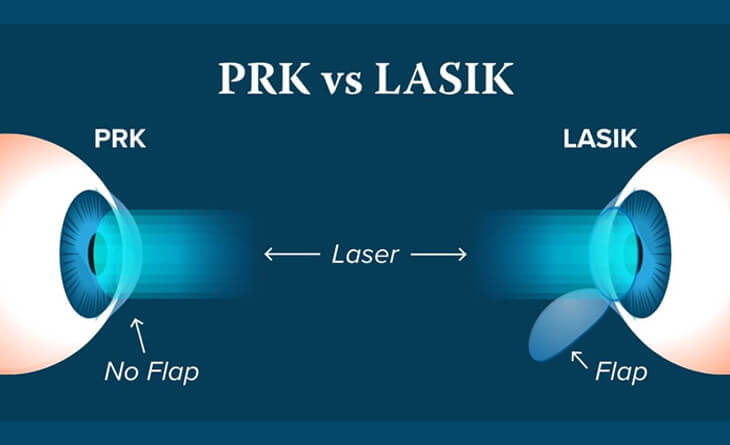
Is SMILE different from LASIK?
Yes!
SMILE (Small Incision Lenticule Extraction) and LASIK (Laser-Assisted in Situ Keratomileusis) are two different types of refractive eye surgery procedures used to correct common vision problems such as nearsightedness, farsightedness, and astigmatism. While both procedures aim to reduce or eliminate the need for glasses or contact lenses, they do so in different ways.
LASIK: LASIK stands for laser-assisted in situ keratomileusis. In LASIK, a thin flap is created on the cornea using a microkeratome (a mechanical blade) or a femtosecond laser. This flap is then lifted to expose the underlying corneal tissue. An excimer laser is used to reshape the exposed corneal tissue to correct the refractive error. After the cornea is reshaped, the flap is repositioned over the treated area, which adheres naturally without suturing. LASIK may be a better option for people with more severe refractive errors. LASIK can cause dry eyes. The recovery time for LASIK is less as compared to SMILE. Most LASIK patients experience improved vision within a day or two.
SMILE: SMILE stands for small incision lenticule extraction. In SMILE, a small incision is made on the cornea’s surface instead of creating a flap. A femtosecond laser creates a small, disc-shaped piece of tissue (lenticule) within the cornea. The eye specialist in Delhi then removes this lenticule through the same small incision, effectively reshaping the cornea to correct the refractive error. Because there is no need to create a corneal flap and only a small incision is made, SMILE is considered a minimally invasive procedure. SMILE is generally a better option for people with mild to moderate myopia or astigmatism. SMILE causes a lower risk of dry eyes. SMILE may have a slightly longer recovery time, with some patients experiencing mild discomfort and slower vision improvement, especially during the first few days after surgery.
Both LASIK and SMILE are effective ways to correct refractive errors. The suitability of the procedure depends on the individual cases.
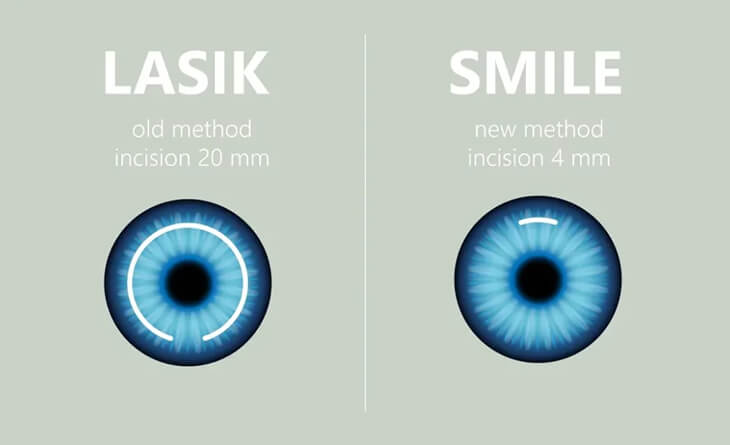
ICL or LASIK – What and When?
ICL and LASIK both are safe and effective procedures for correcting refractive errors. However, both these procedures are different.
LASIK, also known as Laser-Assisted in Situ Keratomileusis, is a common eye surgery that corrects refractive errors by reshaping the cornea. LASIK involves creating a flap with a blade, and then the flap is lifted to reshape the cornea. After reshaping the cornea, the flap is repositioned. LASIK is an effective way to get rid of eyeglasses or contact lenses.
When to Consider LASIK?
LASIK is considered:
- If you have moderate nearsightedness, farsightedness, and astigmatism.
- If you have adequate corneal thickness.
- If you want a procedure with minimal recovery time.
Pros of LASIK:
- Quick recovery: Most people notice improved vision within a day or two.
- Minimally invasive, no implant required.
- Effective for a wide range of prescription levels.
But LASIK is not suitable for everyone. People with thin or steep cornea or high prescription for nearsightedness or farsightedness are not eligible for LASIK. Also, some people may have some systemic issues that make them unfit for lasik. In those cases, they may require alternative options to correct the refractive errors. One such option is ICL.
ICL, or Implantable Collamer Lens, is an intraocular surgery that involves implanting a small, flexible lens over the natural lens inside the eye. The lens is placed in front of the natural lens behind the iris. ICL can correct powers as high as -20 to -25. ICLs are similar to contact lenses but with the advantage of being permanently positioned within the eye.
During the procedure, local anesthesia is given to numb the eye. After that, the eye specialist in Delhi makes a small incision and inserts the ICL through this incision.
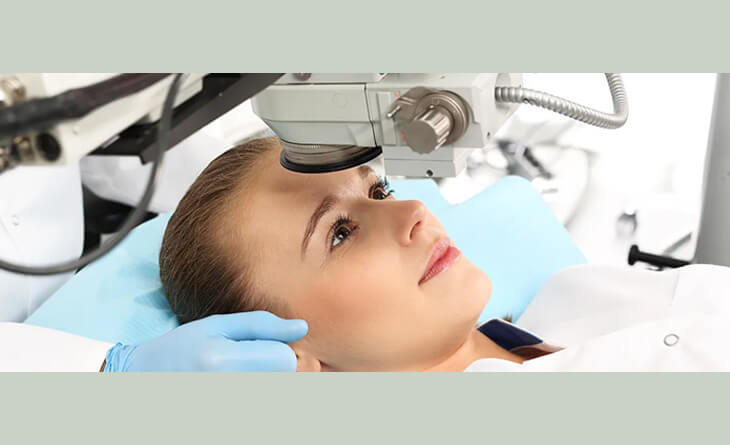
When to Consider ICL?
ICL is a good option for those who
- Are not eligible for LASIK due to thin cornea.
- Have high glass power for nearsightedness or astigmatism.
- Dry eyes or other eye conditions.
- Active lifestyle or participation in sports.
Pros of ICL
- It can treat a wide range of vision problems, including high prescriptions, in which Lasik cannot be done.
- No corneal flap is required to be made.
- There is less risk of causing dry eyes.
Who cannot get ICL done?
ICL implantation needs a minimum space inside the eye and can be done only if that criteria is met. Also, it is avoided in patients with glaucoma and cataract. It also needs regular check ups for a longer period to look for any potential complications.
Also, ICL is more invasive than LASIK, with a high recovery time. Ultimately, the decision of whether to have ICL or LASIK will depend upon your eye. You should talk to your eye specialist in Delhi about your preferences to decide which procedure is right for you. In your case, he/she can provide personalized recommendations and discuss the potential risks and benefits of each procedure.
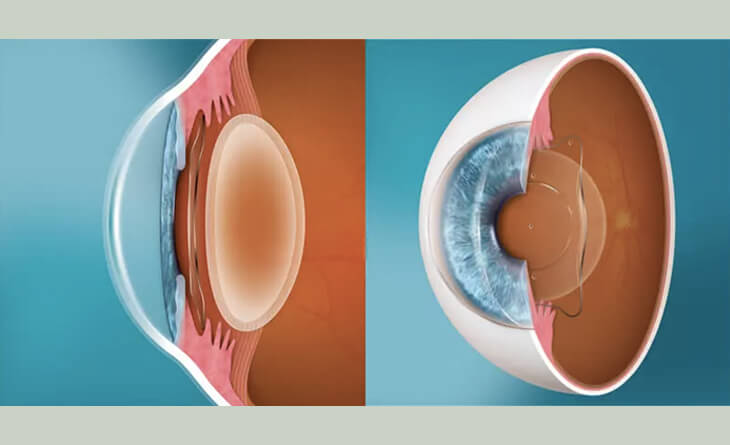
What Are the Risks And Complications of Refractive Surgery?
Refractive surgery is a popular option for people who want to reduce their dependence on glasses or contact lenses by correcting vision problems like nearsightedness, farsightedness, and astigmatism. However, like any surgical procedure, refractive error surgery also carries some risks and complications. Here are the most common complications and risks associated with refractive surgery:
- Dry Eyes: Dry eye syndrome is one of the most common side effects of refractive surgery, especially after LASIK. It can cause discomfort or blurred vision due to poor tear stability on the surface of the eye. These symptoms are usually temporary but can persist longer in some cases. In that case, the eye specialist in Delhi may prescribe artificial tears or other eye drops to lubricate the eye.
- Undercorrection, Overcorrection or Regression: This means that the surgery may not achieve the desired level of vision correction in some cases. This can result in residual refractive errors, meaning you might still need glasses or contact lenses for certain activities. If the laser removes excessive or insufficient corneal tissue or your eye’s natural healing response deviates, your visual results may fall short of the desired outcome. Also, in some cases, over time, the effects of the surgery can regress, causing a return of some or all of the refractive error. However, undercorrection or regression can be treated with additional surgery or vision correction methods.
- Visual Disturbances: Some patients may experience visual aberrations, such as glare, halos, starbursts, or double vision, especially in low-light conditions after the surgery, which may persist for a few days to a few weeks. These aberrations can affect night driving and other activities.
- Infection: Although rare, infection can be a serious complication after refractive surgery. It can usually be treated with antibiotics, but in some cases, it can lead to permanent vision loss.
- Corneal Flap Complications: Manipulating or lifting the flap on the front surface of your eye during surgery can lead to potential complications, such as infections and excessive tearing. Additionally, there is a risk that the outermost layer of corneal tissue may undergo abnormal growth beneath the flap during the healing phase. Loss of corneal flap or detachment of flap can also occur that needs further management.
- Corneal Ectasia: This is a rare but serious complication that can result from thinning and weakening of the cornea after surgery. It can cause a progressive bulging of the cornea, leading to vision distortion. It may require additional surgical procedures or corneal transplants.
- Vision Loss or Changes: In rare cases, surgical complications can lead to vision loss. Additionally, some individuals may experience a decrease in the sharpness or clarity of their vision compared to their pre-surgery condition especially in the dark.
- Epithelial Ingrowth (LASIK): Epithelial ingrowth occurs when the cells from the cornea’s surface layer (known as the epithelium) grow beneath the flap after LASIK surgery. Typically, this condition resolves on its own and does not cause issues. However, in a small percentage of LASIK procedures, people may experience discomfort or blurred vision due to epithelial ingrowth. In such cases, additional surgery may be necessary to lift the flap and remove the epithelial cells.
However, Most of these complications are rare and can be eliminated if the surgery is performed by an experienced surgeon. Therefore, choosing an experienced eye specialist in Delhi and discussing the potential side effects of refractive surgery with your surgeon is essential to make an informed decision.
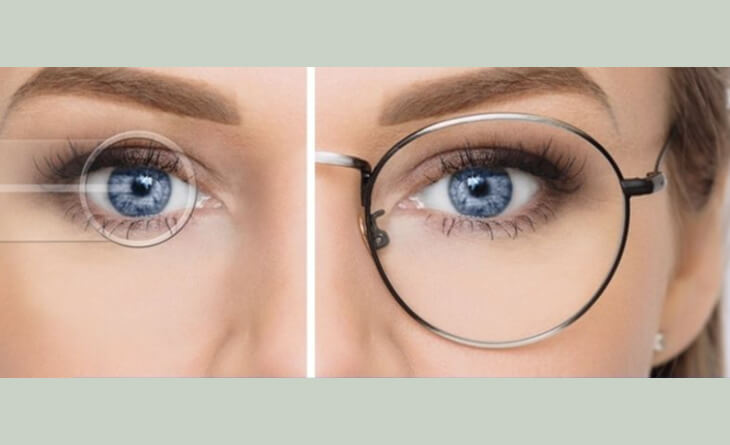
What is the Cost of Getting the Spectacle Removed?
The cost of getting spectacles removed can vary significantly depending on several factors, including your location, the type of vision correction procedure you choose, and any associated medical expenses. Let’s explore all the factors contributing to the spectacle removal cost:
- Vision Correction Options: The first and most important factor in determining the refractive surgery cost is the vision correction method you choose. Primarily, there are two options: laser eye surgery or ICL.
Laser Surgery: LASIK is a more popular eye surgery that involves creating the flap and reshaping the cornea to correct refractive errors and remove spectacles. Two techniques are applied in LASIK surgery: Blade LASIK and Bladeless LASIK. Based on these techniques, LASIK refractive surgery costs between 30000 INR to 1 Lakh for both eyes.
Another laser surgery to remove spectacles is PRK. It is a minimally invasive surgery that uses a laser to reshape the cornea. PRK is typically less expensive than LASIK but can have a longer recovery time.
ICL: ICL is a newer technique to remove spectacles that involves implanting a small lens inside the eye to correct refractive errors. ICL is normally more expensive than LASIK or PRK. But, it can be a useful alternative for those with extremely high prescriptions or unsuitable for other laser eye surgery forms.
The cost depends upon your power, whether cylindrical / toric lens is needed and if you opting for ICL (Staar surgical) or other phakic lenses (Care or Biotech group).
SMILE : SMILE is the most advanced corneal refractive surgery and typically costs between 1 lac-1.25 lac for both eyes.
- Geographic Location of the Hospital or Clinic: The refractive surgery cost can vary greatly based on the geographic location of the clinic or hospital. In general, larger metropolitan areas have higher prices for vision correction procedures due to higher overhead costs. Rural areas may offer more affordable options.
- Surgeon’s Experience and Reputation: The experience and reputation of the surgeon can also impact the refractive surgery cost. Highly experienced and well-known surgeons may charge more for their services. However, it’s essential to prioritize the surgeon’s qualifications and expertise over cost regarding your eyes’ health and safety.
- Technology and Equipment: Nowadays, the latest machines and technologies are used to correct vision problems that could significantly impact the refractive surgery cost. Advanced technologies may offer better outcomes and a more comfortable experience but often come at a higher price. Ensure you understand the technology used and its benefits before making a decision.
- Pre-Operative and Post-Operative Care: The refractive surgery cost is not limited to the procedure itself. You must consider pre-operative evaluations, consultations, and post-operative care. These expenses can include pre-surgery eye exams, medications, follow-up appointments, and any necessary enhancements or adjustments.
Additional fees may be associated with the procedure, such as facility fees, anesthesia fees, and fees for any necessary medications or eye drops, which can also increase the refractive surgery cost.
The cost of spectacle removal depends on various factors. Remember that your long-term eye health is an investment in your quality of life; therefore, it is essential to discuss different procedures and the refractive surgery cost with your surgeon to make an informed decision.
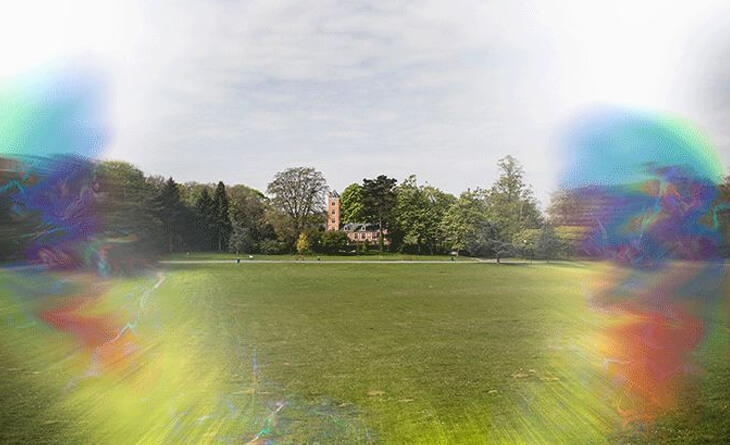
How to Choose the Best Eye Surgeon for Lasik Surgery?
LASIK surgery is a safe and effective way to correct vision problems such as nearsightedness, farsightedness, and astigmatism when performed by an experienced surgeon. Therefore, choosing the best surgeon is essential for the desired outcome and smooth recovery. Here are some tips on choosing the best eye surgeon for LASIK surgery:
- Check the Credentials and Certification of the Surgeon: The first step to finding the best eye specialist in Delhi for LASIK surgery is checking the credentials and certification of the surgeon. Board certification indicates that the surgeon has met stringent standards of education, training, and experience in the field of ophthalmology. Before making a consultation, do your research and check the educational background, active licensure for practice, certifications, and other pertinent details of your ophthalmologist.
- Ask for Referrals and Recommendations: Seek referrals and recommendations from family members, friends, or coworkers who have undergone LASIK surgery. Personal testimonials can provide valuable insights into the surgeon’s skills, bedside manner, and overall patient experience. Additionally, consider checking online reviews and ratings to gather more opinions from previous patients.
- Consultation and Communication: A successful LASIK surgery begins with a thorough consultation. Consider the surgeon’s communication style and willingness to answer your questions during your consultation. They should take the time to understand your specific vision needs and clearly explain the LASIK procedure, potential risks, and expected outcomes. Effective communication ensures that your eye specialist in Delhi understands your expectations and can tailor the surgery to meet your needs. If you feel rushed or uncomfortable during the consultation, it may be a sign to consider other surgeons.
- Facility and Technology: The quality of the surgical facility and the technology used during the LASIK procedure can greatly impact the outcome. Choose a surgeon who operates in a state-of-the-art surgical center or clinic that adheres to strict safety and cleanliness standards. Modern, well-equipped facilities are more likely to offer the latest LASIK technology, enhancing the precision and safety of the procedure.
- Pre-operative and Post-operative Care: LASIK refractive surgery involves pre-operative and post-operative care. A reputable surgeon will provide comprehensive pre-operative evaluations to determine your candidacy for LASIK and prepare you for the procedure. Equally important is their commitment to post-operative care, including follow-up visits and monitoring to ensure your eyes heal correctly and your vision stabilizes. Ask about the surgeon’s post-operative care plan and what you can expect regarding recovery and follow-up appointments. Clear communication can help manage your expectations and ensure a smooth recovery process.
- Complications and Risk Management: While LASIK is generally considered safe, like any surgical procedure, it carries some risks. A competent LASIK surgeon should be honest about potential complications and have a plan to manage them effectively. Ask about their experience in handling complications and what measures they have in place to minimize the risk.
A skilled surgeon will also carefully assess your candidacy and inform you if LASIK refractive surgery may not suit your eyes or if an alternative procedure would be a better option.
Conclusion!
Refractive surgery is a life-changing solution for people with vision problems caused by refractive errors like nearsightedness, farsightedness, and astigmatism. These surgical procedures, including LASIK, PRK, SMILE, ICL, and refractive lens exchange, aim to reduce or eliminate the need for glasses or contact lenses by reshaping the cornea or implanting intraocular lenses. The choice of procedure depends on individual factors and should be discussed with an experienced eye surgeon.
If you are considering refractive surgery or have questions about your vision correction options, don’t hesitate to contact Dr. Anisha Gupta, a trusted and experienced ophthalmologist specializing in refractive surgery. Dr. Gupta and her team are dedicated to providing personalized care and helping you achieve the clear vision you desire.

